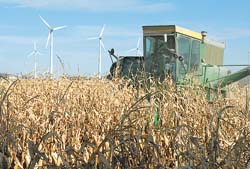Worth County, Iowa Worth County was created in 1851 and was attached to Mitchell county. In 1857 it was fully organized and the town of Northwood became the county seat. Worth County is surrounded by Mitchell County on the east, Cerro Gordo on the south, Winnebago on the west, and Freeborn County, Minnesota on the north.
The first settler in 1853 was a native of Norway, Gulbrand Mellem, who settled on the banks the Shell Rock river, at the present day site of Northwood. The main ethnic group to settle in Worth county were Norwegians. They were attracted to Worth County by he rich black soil which is good for farming.
The land was primarily gentle rolling prairie with an occasional oak grove, especially along the rivers and creeks. The main river is the Shell Rock which has its source in Minnesota and flows southward through Northwood and exits the county in Union township. Its main main tributary is Elk Creek which has its source in Silver Lake township and flows from west to east through Bristol and Brookfield township and joins the Shell Rock river in Kensett township. The Winnebago River catches the SW cornor of the county and flows through Fertile. The only lakes are Brights and Silver Lake in Silver Lake township and the eastern end of Rice Lake in Bristol township.
The population of Worth County is 7,909. The main town is Northwood with a population of 2,050. The population of other towns are as follows: Manly, 1,342; Fertile, 360; Kensett, 280; Grafton, 290; Joice, 231, and Hanlontown, 229.
Worth county is primarily an agricultural county. The entire county is suitable for farming. During the first 100 years the farm size tended to be from 80 to 400 acres. Farmers farmed mainly with horses. The grew oats, corn and hay. Almost all farmers raised chickens (for eggs), milked cows (for the cream) and pigs. Typically each farmer had several hundred chickens, a hundred or so pigs and dozen or two of milking cows. Feeding the livestock was a manual operation, even the milking was done by hand.
More recently the farm size has increased to about 2000 acres, most of land is rented and scattered over the countryside. Most farms are strictly a grain operation. Only a few farmers have livestock.
In the early years all the towns has a lot of small businesses which primarily served the farmers. Now the small towns have many abandoned shops, but each town has a large grain elevator where farmers sell their corn and soybeans.

If you visit Worth County today, you will find the Diamond Jo Casino at the junction of Freeway 35 and highway 105 in Hartland township. Another very noticeable thing is all the wind turbines for generating electicity.
Written by Gordon Felland, 9/10/2008.
